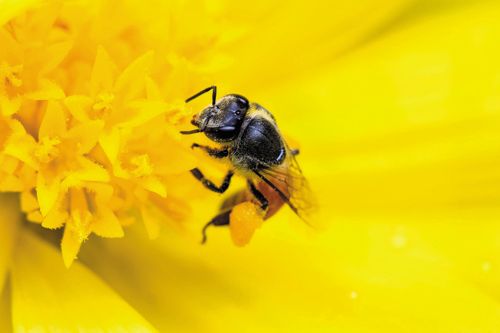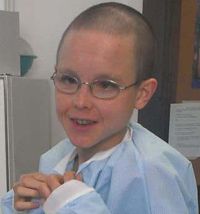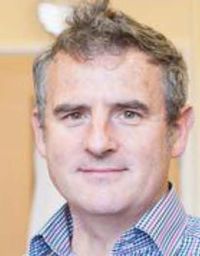Measuring Bumblebee Resistance to Parasites
Evan Palmer-Young of the University of Massachusetts at Amherst, Amherst, Massachusetts, USA, and Philip Stevenson of the Royal Botanic Gardens, Kew, London, UK, spoke to The Column about their work on bumblebee resistance to the trypanosome parasite Crithidia bombi and the role of chromatography in this research.
Photo Credit: SUPANYA/Shutterstock.com

Evan Palmer-Young of the University of Massachusetts at Amherst, Massachusetts, USA, and Philip Stevenson of the Royal Botanic Gardens, Kew, London, UK, spoke to The Column about their work on bumblebee resistance to the trypanosome parasite Crithidia bombi and the role of chromatography in this research. - Interview by Kate Mosford
Q. In 2016, your group published a study analyzing the effects of different phytochemicals against a variety of parasite strains from the bumblebee parasite Crithidia bombi (1). What led your group to begin this study?Evan Palmer-Young: The motivation for the study was to address possible medicinal roles of phytochemicals in plant nectar and pollen for diseased wild bees, such as bumblebees. Plants synthesize a huge variety of phytochemicals that are non-nutritive but often biologically active and may provide defence against herbivores or diseases. Many have been and still are used as medicines to treat disease in humans too-so why not bees? In our agriculturally dominated landscapes, medicinal plants could-if managed correctly-provide a natural way for bees to fight disease.
We have been testing particular phytochemicals for their effects on infection intensity in live bees. But that process is quite laborious, and we were getting different results almost every trial (2). This might have reflected variation in phytochemical resistance among different parasite strains. In this paper (1), I apply an in vitro cell culture technique to screen the direct effects of phytochemicals on a gut parasite of bumblebees, Crithidia bombi. Because the assay allows for simultaneous screening of multiple phytochemicals and parasite strains, it’s a good start for identifying chemicals that might mediate bee disease in ecological settings.
The second big contribution of the paper was to determine if phytochemicals were effective against pollinator infections at the concentrations that occur naturally in nectar and pollen, which are the primary foods for bumblebees and other pollinators. We needed to know, “What is the naturally occurring range of concentrations?” For example, it may be that some chemicals have effects against pathogens at very high doses, but this may not be ecologically relevant if bees and their parasites do not encounter them at these concentrations in the wild. We sampled nectar and pollen of several domestic and wild species to get a start towards characterization of natural concentrations, which together with the in vitro screening, gives an idea of which chemical-rich plants might affect bee disease in landscapes.
Q. Is there a scientific consensus on what is causing the decline in bumblebees?
E.P.-Y: I would say that the current consensus is that bee decline reflects not just one cause, but a confluence of related factors-pathogens, pesticides, and shortage of flowers-that result from land use practices and pollinator management. This is described quite well in a recent review by Dave Goulson from the University of Sussex (3).
Our work was about the pathogen Crithidia bombi, an intestinal parasite of bumblebees. There are phylogenetic relatives of C. bombi that infect honeybees, and the Crithidia genus is very closely related to the trypanosomes that cause leishmaniasis. In addition to C. bombi, there is a swarm of other viruses, bacteria, fungi, and protozoa that also afflict bees. Agricultural intensification has been great for bee diseases, if not for the bees themselves. Managed bees get moved around a lot, and are put in fields at high densities to ensure that crops get maximum pollination services to optimize yields. However, those high bee densities make it very easy for parasites and pathogens to sweep through populations, jumping from one host to the next. High densities of hosts also favour virulent pathogens that take a big toll on their hosts, because if there are plenty of other hosts around, it doesn’t matter if they kill the host they are in, because they can pretty easily find a new host to infect if the present one should die.
Pesticide use is another factor that can certainly weaken pollinators, if not kill them outright. Pesticides are designed to be very toxic to insects. Many pollinators are insects too. Therefore, if pesticides are applied to eradicate pest insects, they are likely to have negative effects on pollinators as well. One of the reasons for pesticide use may again relate to intensive land use, where one or two crops occupy a very large proportion of the landscape and make a big and easy target for pest insects. Moreover, when all of the land is in production, there is very little left over as habitat for beneficial insects that prey on pests, or for pollinators for that matter. It then becomes necessary to truck in huge colonies of honeybees-and the diseases they carry-to provide the services that could have been provided by native pollinators.
Philip Stevenson: There is strong evidence that diseased bees are more susceptible to the effects of insecticides, which you might expect. Imagine having a terrible flu and then getting food poisoning at the same time.
E.P.-Y: A third factor, again related to land use, is lack of flowers. Think about a monoculture. Sure, there are a lot of plants there, but they all bloom at the same time, and then that’s it. Pollinators need a variety of foods throughout the growing season. Imagine trying to feed your family on exclusively fresh, seasonal food if all your land consists of one crop, and you can only have access to resources within, say, a 10-km radius. A more varied agricultural landscape, as well as more wildflowers, would be better than monocultures for pollinators, and possibly also for pest control, which then can result in less pesticide use, less harm to pollinators and predatory insects, and so on.
P.S: An increase in the use of glyphosate in the US associated with crops genetically engineered to tolerate this herbicide is having an added negative impact on flower diversity, with notable impacts on keystone invertebrate species such as the Monarch butterfly as well as bees.
Q. What were the main analytical challenges you encountered in this project and how did you overcome them?E.P.-Y: We were trying to sample nectar and pollen. Trying to collect enough sample for an analysis, it really gives an appreciation of the incredible productivity of bees. You might have to probe 100 flowers to get a single microlitre of nectar. Pollen is not easy either! Most of the pollen you buy at the health food store is gathered by scraping it off the legs of bees as they return from a foraging trip, not by hand!
P.S: Not only are the quantities of nectar very small but the concentrations of target compounds in them can also be small, making their analysis quite a challenge. For example, thymol, which is one of the key compounds in our study, occurs at as little as 10 uM. Nectar on the other hand is a >0.7 M sugar solution, which can obscure polar secondary metabolites that occur at much lower concentrations and elute quickly from the column in liquid chromatography–mass spectrometry (LC–MS).
E.P.-Y: It was also a challenge to get those samples from the US, where they were collected, to the UK, where they were analyzed. We were worried about spoilage especially in the nectar, so we evaporated the nectar prior to shipment. In retrospect, we may have lost some of the volatiles this way, such as the thymol that was so effective against Crithidia and other trypanosomes. I think we might have found higher concentrations if we had used fresh nectar.
Finally, because we had very small samples, we didn’t want to dilute, process, or derivatize them. That meant a lot of infections of highâsugar pollen and nectar extracts onto the columns. There have been a lot of clogged needles that just got caked with sugars. I guess if it was easy, somebody else would have done it by now!
Q. What can gas chromatography–mass spectrometry (GC–MS) and LC–MS offer for this analysis over other techniques? What results did you find?E.P.-Y: Because there is such a great variety of phytochemicals in every type of sample, we used both GC–MS and LC–MS to detect both the volatile and nonvolatile components. For example, the GC–MS is excellent for those wondrous floral fragrances you find when you take the time to smell the flowers, while the LC–MS can detect many of the pigments and phenolic compounds that give flowers their colour. Also, because we are trying to characterize composition in addition to estimating concentrations, having the mass spec detector, as opposed to a flame ionization detector (FID) or UV–vis detector, is useful to get the spectral data necessary for compound identification.
P.S: GC–MS and LC–MS are both useful tools for compound identification in nectar and pollen, and contemporary equipment allows detection of very small quantities of compounds. The large quantities of sugar present the biggest problem because many of the compounds we are looking at are also fairly polar-so not easy to separate when the sugars occur at near 1M. GC is better suited to volatile compounds, which can be partitioned out from the nectar using diethyl ether. GC–MS also benefits from the National Institute of Science and Technology mass spectral library, which facilitates compound identity because mass spectra in GC produces consistent fragmentation of the molecule. LC–MS is better suited to the larger nonvolatile compounds like alkaloids and flavonoids and larger terpenoids, but compound fragmentation in the MS is highly variable under different conditions and in different instruments so libraries are less reliable. At the Royal Botanic Gardens, Kew in the UK, where the chemical analysis for this research was done, we have built up our own in-house spectral library of close to 2000 plant compounds, sourced from our unrivalled herbarium collections of 7 million plant and 1.5 million fungal specimens (but this is still only a fraction of the approximately 50,000 phytochemicals so far described).
We used the chromatography to identify and then quantify the target phytochemicals in nectar so they could be tested at naturally occurring-and therefore ecologically relevant-concentrations. Our work shows that thymol occurs in the nectar of Thymus vulgaris (thyme) on average at around 5–8 ppm (30–50 uM) and at this concentration it is effective against three of the strains tested. Perhaps the next step is to source a variety of thyme that has higher concentrations and use that to deploy in managed field margin strips.
Q: What are the next steps to be taken with your results?E.P.-Y: In terms of the effects of phytochemicals on pollinators, I think we need to see whether the presence of certain plants in the community have a big effect both on infection intensity and on the productivity of bee populations in general, both in terms of their populations and the services they provide to crops and wild plants. And for the screening, testing not just other phytochemicals, but extracts of real plant materials. Because that’s what bees will consume in nature, and because pathogens like C. bombi can readily evolve resistance to one or two phytochemicals (4).
In terms of analytical chemistry, we are just getting started. This is particularly true for the volatile compounds, where it is difficult to estimate concentrations because there is a constant flux of synthesis by the plant and evaporation into the air. I could hardly find any estimates of eugenol concentrations in nectar-it’s not easy to measure. Because you have to sample so many flowers to get enough to analyze, you are constantly opening and closing your collection tube, allowing precious volatiles to escape! Even if you can sample it before it evaporates, then there’s the matter of getting it back to the laboratory for analysis.
References
- E.C. Palmer-Young, B.M. Sadd, P.C. Stevenson, R.E. Irwin, and L.S. Adler, Scientific Reports6, 37087 (2016).
- L.P. Thorburn, L.S. Adler, R.E. Irwin, and E.C. Palmer-Young, F1000Research4, 880 (2015).
- D. Goulson, E. Nicholls, C. Botías, and E.L. Rotheray, Science347(6229), (2015).
- E.C. Palmer-Young, B.M. Sadd, and L.S. Adler, Journal of Evolutionary Biology doi:10.1111/jeb.13002 (2016).
- E.C. Palmer-Young, D. Veit, J. Gershenzon, and M.C. Schuman, PLOS ONE, 1–22 (2015).

Evan Palmer-Young graduated from Cornell University in 2009 in biology with a neurobiology and behaviour concentration. He conducted an independent study project with Paul Sherman on the antimicrobial properties of the fermented milk kefir. In 2009 he had a National Science Foundation Research Experience for Undergraduates (NSF REU) at the Institute of Ecosystem Studies (IES, Millbrook, New York, USA, www.ies.org) studying nitrate reduction in sediments of Onondaga Lake (Syracuse, New York, USA). He spent 2009–2011 at the Max Planck Institute for Chemical Ecology (http://ice.mpg.de) in Jena, Germany. Working with Meredith Schuman, Jonathan Gershenzon, and Ian Baldwin, he tested the role of sesquiterpenes in plant resistance to oxidative stresses. He also explored the contribution of plant volatiles to local formation of aerosols (5). He is currently studying how different dosages and mixtures of floral metabolites influence bumblebee resistance to their trypanosome parasite Crithidia bombi at the University of Massachusetts at Amherst, Massachusetts, USA.

Philip Stevenson is a senior research leader in chemical ecology at the Royal Botanic Gardens, Kew, London, UK, and a professor of plant chemistry at the University of Greenwich, Medway, UK. He leads Kew’s research on the ecological function of plant and fungal chemicals, the interactions chemistry mediates between plants and other organisms, and the potential to use plants sustainably for enhancing ecosystems and improving horticulture. Professor Stevenson obtained his B.Sc. studying applied biology at Brunel University in 1988 and was awarded a Ph.D. on resistance mechanisms in Arachis spp. to the tobacco armyworm Spodoptera litura from the University of London in 1992. His research focuses on the chemistry that drives pollinator–plant interactions, how plant chemicals affect insect behaviour and ecosystem function, for example through pollinator exposure to invertebrate toxins or provision of adequate nutrition, and the potential of plants to provide environmentally benign alternative pest control technologies in smallholder agriculture.
E-mail:ecp52@cornell.edu / P.Stevenson@kew.orgWebsite:https://sites.google.com/a/cornell.edu/evan-palmer-young/ http://www.kew.org/science-conservation/research-data/science-directory/people/stevenson-phil

New Method Explored for the Detection of CECs in Crops Irrigated with Contaminated Water
April 30th 2025This new study presents a validated QuEChERS–LC-MS/MS method for detecting eight persistent, mobile, and toxic substances in escarole, tomatoes, and tomato leaves irrigated with contaminated water.
University of Tasmania Researchers Explore Haloacetic Acid Determiniation in Water with capLC–MS
April 29th 2025Haloacetic acid detection has become important when analyzing drinking and swimming pool water. University of Tasmania researchers have begun applying capillary liquid chromatography as a means of detecting these substances.

.png&w=3840&q=75)

.png&w=3840&q=75)



.png&w=3840&q=75)



.png&w=3840&q=75)










